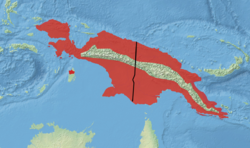| Big-eared flying fox | |
|---|---|
 | |
| Scientific classification | |
| Kingdom: | Animalia |
| Phylum: | Chordata |
| Class: | Mammalia |
| Order: | Chiroptera |
| Family: | Pteropodidae |
| Genus: | Pteropus |
| Species: | P. macrotis |
| Binomial name | |
| Pteropus macrotis Peters, 1867 | |
 | |
| Distribution of the big-eared flying fox | |
The big-eared flying fox (Pteropus macrotis) is a species of bat in the family Pteropodidae, larger bats who subsist largely on fruits. The species is distributed across a range in Indonesia, Papua New Guinea and islands nearing the Cape York Peninsula at the northeast of Australia, at elevations less than 500 metres and often in coastal mangroves. [1]
